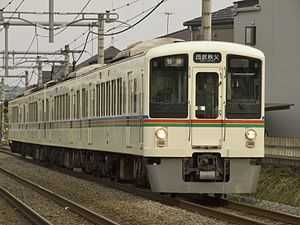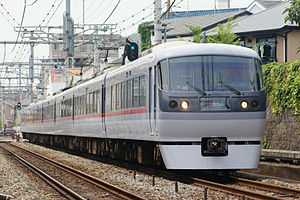Seibu 4000 series
| Seibu 4000 series | |
|---|---|
|
A 4000 series set on the Seibu Chichibu Line, August 2009 | |
| In service | 1988 - Present |
| Constructed | 1988-1992 |
| Refurbishment | 2002 |
| Number built | 48 vehicles (12 sets) |
| Number in service | 48 vehicles (12 sets) |
| Formation | 4 cars per trainset |
| Fleet numbers | 4001-4023 |
| Operator | Seibu Railway |
| Depot(s) | Musashigaoka |
| Line(s) served | Seibu Ikebukuro Line, Seibu Chichibu Line, Chichibu Main Line |
| Specifications | |
| Car body construction | Steel |
| Car length | 20 m (65 ft 7 in) |
| Doors | 2 pairs per side |
| Maximum speed | 105 km/h (65 mph) |
| Electric system(s) | 1,500 V DC |
| Current collection method | overhead catenary |
| Track gauge | 1,067 mm (3 ft 6 in) |
The Seibu 4000 series (西武4000系) is an electric multiple unit (EMU) train type operated by the private railway operator Seibu Railway mainly on Seibu Chichibu Line services in Saitama Prefecture, Japan since 1988.[1]
Design
The 4000 series trains were built between 1988 and 1992 by combining electrical equipment from former 101 series EMUs with new steel bodies.[1] The trains are finished in a livery of ivory white with blue, red, and green stripes along the waist line, the team colours of the Saitama Seibu Lions baseball team.[1] The driving cabs have a similar configuration to the earlier 101 series and 2000 series EMUs, with a left-hand master controller and right-hand brake control.[1]
-

The driving cab console
Operations
The fleet of four-car trains is primarily used on local driver only operation services on the Seibu Chichibu Line between Hannō and Seibu Chichibu, but the trains are also used as eight-car formations on through "Rapid Express" train services from Ikebukuro on the Seibu Ikebukuro Line to Mitsumineguchi and Nagatoro on the Chichibu Main Line.[1] These trains divide and couple at Yokoze, with separate portions for Mitsumineguchi and Nagatoro.[1]
Fleet
As of 1 April 2013, the fleet consists of twelve four-car sets, numbered 4001 to 4023, based at Musashigaoka depot.[2]
Formations
Sets are formed as shown below with two motored ("M") cars and two non-powered driving trailer ("Tc") cars, and the Tc1 car at the southern (Ikebukuro) end.[2]
| Designation | Tc1 | M1 | M2 | Tc2 |
|---|---|---|---|---|
| Numbering | 400x | 410x | 410x | 400x |
- The M1 car is fitted with two single-arm pantographs (originally lozenge-type pantographs).[1][2]
Interior
Seating mainly consists of fixed 4-person facing seating bays, with longitudinal bench seating next to the doorways.[1] The Tc1 car has a toilet.[2]
-

Train interior view
-

4-person seating bay
-

Toilet and priority seating
-

Wheelchair space
History
The first train entered service in 1988, with twelve four-car sets built by 1992.[1] The fleet was refurbished in 2002 for use on wanman driver only operation services on the Seibu Chichibu Line. Modifications included the addition of automatic passenger announcements.[1]
References
- ↑ 1.0 1.1 1.2 1.3 1.4 1.5 1.6 1.7 1.8 1.9 私鉄車両年鑑2013 [Japan Private Railways Annual 2013]. Tokyo, Japan: Ikaros Publications Ltd. 20 March 2013. p. 201. ISBN 978-4-86320-693-9.
- ↑ 2.0 2.1 2.2 2.3 私鉄車両編成表 2013 [Private Railway Rolling Stock Formations - 2013]. Japan: Kotsu Shimbunsha. 30 July 2013. p. 62. ISBN 978-4-330-39313-1.
External links
| Wikimedia Commons has media related to Seibu 4000 series. |
- Seibu 4000 series train information (Japanese)
| ||||||||||||||||||||

